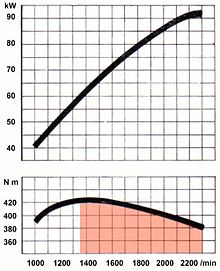Torque increase
In internal combustion engine technology, the difference between the nominal torque and the maximum torque of an engine is referred to as the torque increase or torque reserve . The increase in torque is therefore a characteristic of the power reserves of an engine. It is given in percent. The increase in torque does not necessarily indicate the performance of an engine. In order to be able to compare two motors on the basis of their torque increase, the nominal speeds must be the same.
principle
The increase in torque results from the fact that an internal combustion engine delivers its maximum output at its rated speed , but not its maximum torque. If the drive torque of a motor is insufficient at the nominal speed to do a certain job , the speed drops. In the process, however, the torque increases, which means that the torque delivered by the motor is again greater than that required to do the work. This means that the engine speed does not decrease any further. It is characteristic that there is a drop in speed when the torque increases .
term
The term torque increase is used above all in the case of particularly high-torque industrial engines with large cubic capacities in agricultural machines, in particular agricultural tractors , to express the performance of an engine. It is not used in smaller engines with a smaller displacement, especially passenger car engines.
Calculation of the torque increase
In the case of internal combustion engines, the maximum torque, the rated power and the rated speed are usually specified. The nominal torque, which forms the reference basis, can be calculated from the nominal speed and nominal power. The maximum torque corresponds to the nominal torque .
The percentage torque increase of a motor can be calculated with the following formula, the maximum torque (in Nm), the nominal power (in W) and the nominal speed (in min −1 ) must be given:
Calculation of the nominal torque
Calculation of the percentage torque increase
rating
A torque increase of less than 20% is considered to be moderate for tractor engines, 20–30% as good, and more than 30% as very good. A torque curve that drops steeply with increasing speed is required for a high torque increase; the maximum torque is not decisive. However, if the increase in torque is too great, the usable speed range of a motor is limited and it can only be operated with difficulty in the optimal speed range. Motors with a high torque increase of more than 30% are mainly found in work machines.
Examples
example 1
In the example the engine VW EA189 is given. This engine is a diesel engine designed for passenger cars with a displacement of 1968 cm 3 and an output of 103 kW at 4200 min −1 , the maximum torque is 320 Nm. To at 4200 min -1 to afford 103 kW, a torque of 234.2 N · m must be present. This is the nominal torque . As a result, the engine has a torque increase of 36.6%.


(Source:)
Example 2
The example shows the motor 4 VD 14.5 / 12-1 SRW . This engine is a developed for medium-duty vehicles diesel engine with 6560 cm 3 capacity and 92 kW at 2300 min -1 , the maximum torque of 422 N · m. To at 2300 min -1 to provide 92 kW, a torque of 382 N · m must be present. As a result, the engine has a torque increase of 10.5%.
Example 3
In the example of the engine MAN D2862 is given, a diesel engine for large agricultural machinery with 24.2 dm 3 capacity and a rated power of 588 kW at 1800 rpm -1 , it must 3.12 kN · m torque applied. The maximum torque is 4.28 kN · m at 1400 min -1 . The difference between 3.12 and 4.28 is 1.16, this value corresponds to 37.2% of 3.12; 37.2% is the torque increase of the engine.
literature
Sylvain Boéchat: Buying a tractor: what do the engine data say? In: Swiss agricultural technology . No. 5 , 2012, p. 43–45 ( agri-ecodrive.ch [PDF]).
See also
Remarks
- ↑ The nominal power of motors is usually given in kilowatts ( thousand watts) (kW) and must be multiplied by. 100 kW become 100,000 W.
Individual evidence
- ↑ The 2.0 l TDI engine with common rail injection system, design and function Volkswagen AG, self-study program 403, page 5. Print no .: 000.2812.03.00, technical status October 2007, accessed at motor-talk.de on November 8, 2016 (PDF; 1.4 MB)
- ↑ Author collective VEB IFA Motorenwerke Nordhausen : Diesel engine 4 VD 14.5 / 12-1 SRW repair manual . Second edition, VEB Fachbuchverlag, Leipzig, 1987. Page 8
- ↑ D2868 and D2862 diesel engines for construction, agricultural and special machines.









